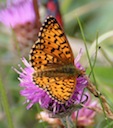 On the Lizard, this pretty butterfly is mainly a coastal species.
On the Lizard, this pretty butterfly is mainly a coastal species.
Photo: Amanda Scott
Scientific name: Boloria selene
Cornish name: ‘Tikki-dui’ is the general word for butterfly
 If you see a distinctive orange-coloured butterfly flying near the ground and nectaring on knapweed, thistles or brambles, there is a reasonable chance it could be a Small Pearl-bordered Fritillary. In the south, it is generally a butterfly of woodland clearings, but on The Lizard it is mainly a coastal species, where it has adapted to bracken scrub and damp grassland (Wacher et al., 2003).
If you see a distinctive orange-coloured butterfly flying near the ground and nectaring on knapweed, thistles or brambles, there is a reasonable chance it could be a Small Pearl-bordered Fritillary. In the south, it is generally a butterfly of woodland clearings, but on The Lizard it is mainly a coastal species, where it has adapted to bracken scrub and damp grassland (Wacher et al., 2003).
The uppersides of its wings have black markings, while the undersides of the hind-wings have pretty pearly markings bordered in black, including the row of pearls round the edge that give it its name, and a large-ish central black spot. It is very similar to the more endangered Pearl-bordered Fritillary (Boloria euphrosyne), which also flies low to the ground, and both share similar habitats (although the Small Pearl-bordered Fritillary is more widely distributed and more likely to use damper habitats). They can be distinguished by the different patterning on the underside of the hind-wings: in particular the seven silvery spots round the edge of the Pearl-bordered Fritillary’s hind-wing underside are bordered in red rather than black, and the central black spot is smaller.
The main flight period is from the beginning of May until June. In Cornwall, as in some other southern parts of the country, there is a partial second brood flying from August into the early part of September. The larval food plants are Common Dog-violet and Marsh Violet. The caterpillars hibernate through the winter, and then pupate in leaf litter in the spring before emerging as adults.
Like many of our native butterfly species, the Small Pearl-bordered Fritillary has suffered from rapidly declining populations, particularly in central and eastern parts of England where it is almost extinct, mainly due to habitat destruction. It forms small discrete colonies that are not particularly mobile, and so its ability to colonise new sites is limited. The national charity Butterfly Conservation have undertaken habitat restoration and management to protect this butterfly in an area of County Durham, showing that a landscape-scale integrated approach can have great success (Ellis et al., 2012).
Did you know…?
…The butterfly we see in England, Wales and parts of Scotland is the subspecies Boloria selene selene. In north-west Scotland, another sub-species − Boloria selene insularum − occurs, which has brighter colours and markings.
…The caterpillars of the Small Pearl-bordered Fritillary do not like direct sunlight, making them harder to find than those of the Pearl-bordered Fritillary, which are quite happy to bask in the sunshine.
More information and references:
Ellis, S., Bourn, N. and Bulman, C., 2012. Landscape-scale Conservation for Butterflies and Moths: Lessons from the UK. Butterfly Conservation, Wareham, Dorset.
Wacher, J., Worth, J. and Spalding, A., 2003. A Cornwall Butterfly Atlas. Pisces Publications, Newbury, Berkshire.
Whalley, P. and Lewington, R., 2009. The Pocket Guide to Butterflies. Bounty Books, London.
Published: August 2013
Author: Amanda Scott
Photos: Amanda Scott

